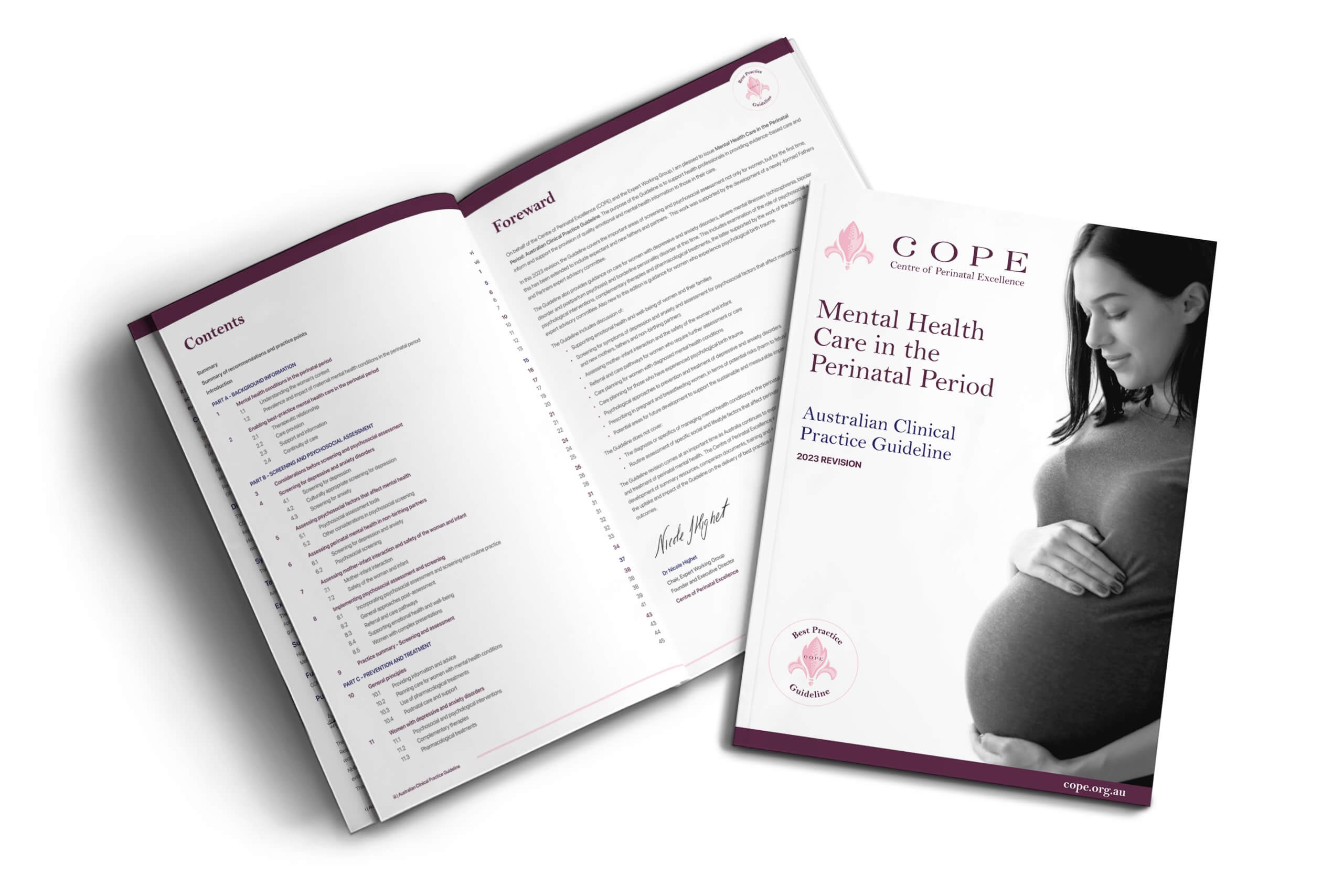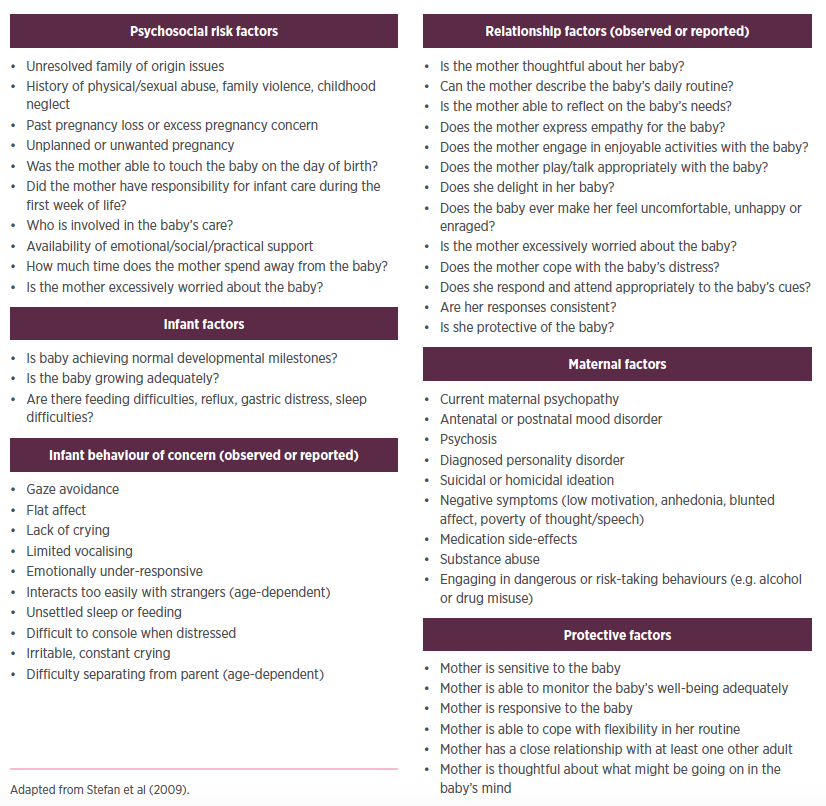Perinatal Mental Health Guideline: Summary for maternal child and family health nurses

Screening for depression and anxiety and assessing psychosocial risk factors are integral parts of postnatal care that should be offered to all women. It is also important that women receive psychosocial support and that any difficulties in the mother-infant relationship are identified.
Screening and assessment
Before screening and assessment
- Undertake training in screening and assessment.
- Make sure that appropriate follow-up care is available if required, including for situations where there are concerns for the safety of the woman, the baby or other children in the woman’s care.
- Identify health professionals from whom you can seek advice, supervision or support regarding mental health care in pregnancy.
Providing woman-centred care
- Give all women information about common mental health conditions and the risk factors that may increase the likelihood of experiencing them during pregnancy (see Resources section below).
- Explain that depression and anxiety are common in the postnatal period and that screening and assessment is part of usual care. Results will remain confidential, unless there is a perceived or actual risk of harm to the woman or her baby as there is a duty of care for this to be communicated.
- Consider who should be present so that the woman feels safe during screening and assessment. While the presence of significant other(s) is often helpful, be sensitive about whether it is appropriate to continue with psychosocial assessment while they are in the room. Only screen for family violence when alone with the woman.
Screening for depression and anxiety
- Why — In Australia, around one in ten women experience depression and one in six experience anxiety in the postnatal period.
- When — Conduct screening as 6–12 weeks after the birth and at least once in the first postnatal year or at any time if clinically indicated.
- How — The Edinburgh Postnatal Depression Scale (EPDS) is the recommended tool for screening for depression. It is usually completed by the woman on her own, preferably without consulting others. The EPDS may also be administered verbally. As part of clinical assessment, use anxiety items from existing screening tools (e.g. EPDS Items 3, 4 and 5, Depression Anxiety Stress Scale (DASS) anxiety items and K-10 Items 2, 3, 5 and 6) and relevant items in structured psychosocial assessment tools (e.g. the Antenatal [Psychosocial] Risk Questionnaire [ANRQ] with postnatal items).
- Cultural considerations — When screening Aboriginal and Torres Strait Islander women, consider use of translations and adaptations of the EPDS developed in consultation with women from Aboriginal communities. If use of the EPDS is considered inappropriate, involve Aboriginal health workers where possible. For migrant and refugee women, use appropriately translated versions of the EPDS with culturally relevant cut-off scores. If you and the woman do not speak the same language, involve an interpreter.
- Responding to EPDS scores
- Arrange further assessment of a woman with an EPDS total score of 13 or more.
- For a woman with an EPDS score of 10 to 12, monitor and repeat the EPDS in 4–6 weeks.
- For a woman positive score on Question 10 of the EPDS, undertake or arrange immediate further assessment and, if there is any disclosure of suicidal thoughts, take urgent action in accordance with local protocol/policy.
- If a woman has high scores on Items 3, 4 and 5, she may be experiencing anxiety even if her total score is lower than 10.
Assessing psychosocial factors that affect mental health
- Why — Psychosocial assessment allows identification of circumstances (past and present) that affect a woman’s mental health. The number and type of factors identified influences the care pathway.
- When — Undertake psychosocial assessment in conjunction with screening for depression and anxiety.
- How — Psychosocial assessment can be undertaken as part of the clinical interview and/or using a structured psychosocial assessment tool. If using a tool to assess psychosocial risk, administer the ANRQ together with questions exploring the presence of family violence (with the woman on her own) and drug and alcohol use.
- Cultural considerations — Consider a more conversational approach when assessing psychosocial risk among Aboriginal and Torres Strait Islander or migrant and refugee women, with involvement of Aboriginal and Torres Strait Islander health workers or multicultural health workers, where possible. Consider psychosocial risk factors that may be relevant to specific groups (e.g. lack of secure housing, experience of trauma).
- Responding to assessment
- A score of 23 or more suggests the high presence of risk factors, placing a woman at significantly increased risk of perinatal mental health problems.
- Discuss with the woman the possible impact of psychosocial risk factors (she has endorsed) on her mental health and provide information about available assistance.
Administration of screening tools
- Screening and assessment can be undertaken using digital and or pen-and-paper approaches (see Resources section below).
Supporting emotional health and well-being
- At every antenatal visit, enquire about the woman’s emotional wellbeing and provide access to information about emotional and mental health during pregnancy (see screening and assessment tools).
- Provide the woman with advice on lifestyle issues and sleep, as well as assistance in planning how this advice can be incorporated into their daily activities during pregnancy. This can be achieved by encouraging women to sign-up to the free Ready to COPE e-Guide to early parenthood.
- If a woman agrees, provide information to and involve her significant other(s) in discussions about her emotional wellbeing and care.
Mother-infant interaction
- Assess the mother-infant interaction as an integral part of postnatal care and refer to a parent-infant therapist as available and appropriate.
- Seek guidance/support from Aboriginal and Torres Strait Islander health professionals or bicultural health workers when assessing mother-infant interaction in Aboriginal and Torres Strait Islander or migrant and refugee women to ensure that assessment is not informed by unconscious bias.
- Assess the risk of harm to the infant if significant difficulties are observed with the mother-infant interaction, the woman discloses that she is having thoughts of harming her infant and/or there is concern about the mother’s mental health.
This is an adapted Summary of the 2023 Guideline for MC&FHN.
To access the full 2023 National Guideline – click here
Resources
Resources for women and their families
COPE website – The COPE website contains extensive information and fact sheets on perinatal mental health disorders, and links to support services for women and their families.
Ready to COPE – A free app that provides information about emotional health and wellbeing across the perinatal period. Also available as an email series in multiple languages.
eCOPE Directory – eCOPE includes services and professionals that have a special focus on emotional and mental health in pregnancy and following the birth of a baby.
Resources for health professionals
COPE website – The COPE website contains extensive information, screening tools, online training programs and fact sheets specifically for health professionals.
COPE online training – This free accredited online training is available for maternal child and family health nurses (ten hours CPD).
